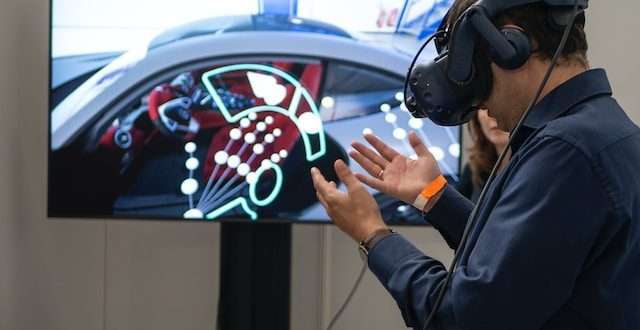Welcome to the cutting-edge world of virtual reality operating systems, where innovation meets seamless user experiences, and a new digital frontier unfolds before us. In this blog, we delve into the realm of web technology and how it intertwines with the rapid rise of virtual reality operating systems. As experts in web development technologies, we believe that understanding the potential of virtual reality operating systems is crucial for businesses and individuals alike. Buckle up as we embark on this immersive journey that will uncover the true potential of VR operating systems and how they are shaping the future of computing, web hosting, cloud services, and more.
Virtual Reality Operating Systems: Revolutionizing the Web Computing Landscape
What are Virtual Reality Operating Systems?
At the heart of the virtual reality revolution lies the concept of virtual reality operating systems (VR OS). These innovative systems are software platforms designed to run on virtual reality devices, such as VR headsets, enabling users to interact with digital environments in unprecedented ways. Unlike traditional operating systems that facilitate interactions between users and computers, VR OS facilitates interactions between users and immersive virtual environments. With advanced web technologies, VR OS has opened up a realm of possibilities, from gaming and entertainment to education and enterprise applications.
Unveiling the Advancements in Web Development Technologies
The rise of virtual reality operating systems is closely tied to the advancements in web development technologies. Developers have harnessed the power of HTML5, WebGL, and WebXR to create interactive and visually stunning virtual experiences. This synergy of technologies has allowed for the seamless integration of web applications with VR environments, making them accessible through web browsers. As a result, web developers can now craft VR experiences without the need for complex standalone applications, ushering in a new era of convenience and accessibility.
Embracing a New Era of Web Hosting for VR Applications
The integration of virtual reality operating systems with web technologies has also given rise to a new era of web hosting. Traditional web hosting services are no longer sufficient to handle the demands of VR applications, which require high-performance servers and low latency. As a solution, specialized VR hosting providers have emerged, offering optimized environments tailored for VR content delivery. This development has laid the groundwork for a seamless user experience, minimizing lag and enhancing immersion in VR worlds.
The Power of Cloud in Driving VR OS Innovation
Central to the success of virtual reality operating systems is the utilization of cloud technology. The cloud plays a pivotal role in enhancing the capabilities of VR OS by offloading computational tasks, reducing the hardware requirements for VR devices, and enabling remote collaboration in virtual spaces. Cloud-based VR OS solutions empower users to access VR experiences across various devices, making the technology more accessible to a wider audience.
The Unparalleled User Experience of VR Operating Systems
Immersive Gaming: A Gateway to Virtual Realms
Virtual reality operating systems have disrupted the gaming industry, offering gamers an unparalleled level of immersion and interactivity. With the integration of advanced web technologies, developers can create visually stunning and dynamic gaming experiences accessible through standard web browsers. Gamers can now explore vast virtual realms, engage in thrilling adventures, and connect with friends from across the globe—all from the comfort of their VR headsets.
Bridging the Gap in Education and Training
VR OS has unlocked new possibilities in the realm of education and training. From virtual classrooms to training simulations, educational institutions and businesses are leveraging the power of VR to enhance learning experiences. Web-based VR applications allow educators to create engaging and interactive lessons that cater to different learning styles. Additionally, employees can undergo immersive training sessions, preparing them for real-life scenarios in a risk-free environment.
Revolutionizing Business Collaboration and Communication
The integration of VR OS with web technologies has paved the way for enhanced collaboration and communication in the business world. Virtual meetings and conferences have become more engaging and productive, eliminating the need for physical travel and enabling teams from different parts of the world to come together in virtual boardrooms. As VR operating systems continue to evolve, businesses are finding innovative ways to streamline their operations and boost productivity.
Overcoming Challenges: The Road to Widespread Adoption
Hardware Limitations: A Hurdle to Overcome
Despite the remarkable progress in virtual reality operating systems, hardware limitations remain a significant challenge to widespread adoption. VR devices can be expensive, and not all computers are equipped to handle the demands of VR experiences. As technology advances, however, we can expect more affordable and powerful VR devices to enter the market, making VR OS more accessible to the masses.
User Interface and Experience Refinements
Creating an intuitive user interface and seamless user experience is crucial for the success of VR operating systems. Developers are constantly working on refining VR interactions, minimizing motion sickness, and improving overall comfort. As user interfaces become more user-friendly and natural, the appeal of VR OS is expected to grow among a broader audience.
Content Creation and Adoption
Content is king, even in the virtual reality realm. For VR operating systems to thrive, a diverse and captivating range of VR content needs to be readily available. This includes everything from gaming and entertainment to educational and enterprise applications. Content creators must continue pushing boundaries, enticing users with new and exciting experiences that keep them coming back for more.
Final Words
The rise of virtual reality operating systems is a testament to the boundless potential of web technology in reshaping our digital landscape. As VR OS continues to evolve, it will unlock new possibilities in gaming, education, business, and beyond. Embracing this new digital frontier can lead to a more immersive, interconnected, and enriched future for all.
Commonly Asked Questions
Q1: What is the primary focus of virtual reality operating systems?
A1: The primary focus of virtual reality operating systems is to enable users to interact with digital environments in immersive ways through virtual reality devices, such as VR headsets.
Q2: How are web development technologies influencing VR OS?
A2: Web development technologies, such as HTML5, WebGL, and WebXR, are crucial in creating interactive and visually stunning VR experiences accessible through web browsers.
Q3: What role does cloud technology play in VR OS innovation?
A3: Cloud technology enhances VR OS capabilities by offloading computational tasks, reducing hardware requirements, and enabling remote collaboration in virtual spaces.
Q4: How are VR operating systems revolutionizing education and training?
A4: VR OS is transforming education and training by offering virtual classrooms, training simulations, and engaging lessons that cater to different learning styles.
Q5: What challenges does VR OS face in widespread adoption?
A5: VR OS faces challenges related to hardware limitations, user interface refinements, and the availability of diverse and captivating VR content.
 webfily
webfily



